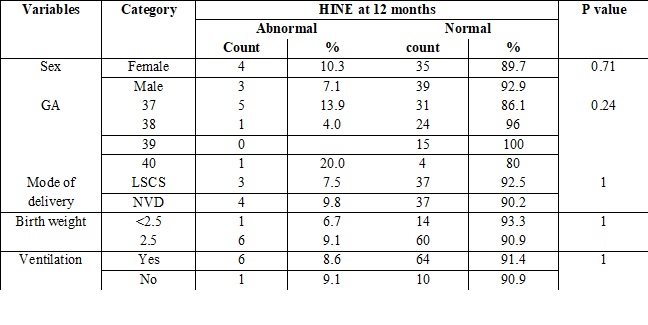Neuro-Developmental follow up of high-risk newborns using hammersmith-dubowitz method
Abstract
Background and Objectives: High risk infants are prone to delay in neurological development due to perinatal damage sustained by the brain and nervous tissue. Despite being on regular follow-up, delayed neurological development is often missed even by experienced examiners as most of the examination and history are subjective. We aim to validate an objective scoring system- the Hammersmith-Dubowitz neurological exam which was extensively researched and developed taking into consideration normal responses from a normal cohort.
Materials and Methods: Over a period of two years, 112 infants were categorized as high-risk newborns and were followed up for a period of one year of age.The children underwent detailed milestone assessment, physical and neurological examination by two independent examiners along with objective scoring with Hammersmith infant neurological exam. Any abnormality in these tests was considered delayed development.
Results: Of the 112 infants, 102 came for at least one follow up and 81 completed one year follow up with a mean follow up duration of 9.42 months. On the combined assessment scale of developmental, physical and complete neurological examination 7.84% infants were found to be abnormal. However, on objective assessment with Hammersmith neurological examination 16.67 % of the infants were found to have abnormal neurological development.
Conclusion: Hammersmith neurological examination is a useful objective scoring tool to identify delayed neurological development early.
Downloads
References
2. Gupta SN, Kechli AM, Kanamalla US. Intracranial hemorrhage in term newborns: management and outcomes. Pediatr Neurol. 2009 Jan;40(1):1-12. doi: 10.1016/j.pediatrneurol.2008.09.019.[pubmed]
3. Guralnick MJ, Bennett FC. The effectiveness of early intervention for at-risk and handicapped children. Academic Press; 1987.
4. US Department of Education. To assure the free appropriate public education of all children with disabilities (Individuals with Disabilities Education Act, Section 618). Twenty-third Annual Report to Congress on the Implementation of the Individuals with Disabilities Education Act 2001. Accessed from http://www.ed.gov/ about/reports/annual/osep/ 2001/index.html on May 19, 2005.
5. Jayaranza S, Bhat JS. Epidemiological Profile of Children with Autism in Comparison with other Communicatively Challenged children Attending Early Intervention Centre. Ind Romeo DMM, Cioni M, Scoto M, Mazzone L, Palermo F, Romeo MG.
6. Romeo DM, Cioni M, Scoto M, et al. Neuromotor development in infants with cerebral palsy investigated by the Hammersmith Infant Neurological Examination during the first year of age. Eur J Paediatr Neurol. 2008 Jan;12(1):24-31. Epub 2007 Jul 2.DOI:10.1016/j.ejpn.2007.05.006.[pubmed]
7. Setänen S, Lehtonen L, Parkkola R, et al. Prediction of neuromotor outcome in infants born preterm at 11 years of age using volumetric neonatal magnetic resonance imaging and neurological examinations. Dev Med Child Neurol. 2016 Jul;58(7):721-7. doi: 10.1111/dmcn.13030. Epub 2016 Jan 27.[pubmed]
8. Haataja L, Mercuri E, Regev R, et al. Optimality score for the neurologic examination of the infant at 12 and 18 months of age. J Pediatr. 1999 Aug;135(2 Pt 1):153-61.[pubmed]
9. Einspieler C, Prechtl HF, Ferrari F, Cioni G, Bos AF. The qualitative assessment of general movements in preterm, term and young infants—review of the methodology. Early human development. 1997 Nov 24;50(1):47-60.
10. Deluca SC, Echols K, Law CR, Ramey SL. Intensive pediatric constraint-induced therapy for children with cerebral palsy: randomized, controlled, crossover trial. Journal of child neurology. 2006 Nov;21(11):93
11. Meenai Z, Longia S. A study on prevalence and antecedents of developmental delay among children less than 2 years attending well baby clinic. Peoples J Sci Res. 2009;2:9-12.
12. Bhattacharya T, Ray S, Das DK. Developmental delay among children below two years of age: a cross-sectional study in a community development block of Burdwan district, West Bengal. International Journal Of Community Medicine And Public Health. 2017 Apr 24;4(5):1762-7.
13. International Institute for Population Sciences (IIPS) and Macro International. 2007. National Family Health Survey (NFHS-3), 2005–06: India: Volume I.
14. Mumbai.Simeonsson, R., Sharp, M. Developmental delay: Signs and symptoms. In: Hoekelman R, et al., ed. Primary Pediatric Care (2nd ed). St. Louis: Mosby Co (1992).
15. Janson H, Smith L. Norskmanualsupplementtil “Ages and stages questionnaires”. Oslo: R.BUP, Regionsenter for barne- ogungdomspsykiatri, HelseregionØst/Sør; 2003.
16. Alvik A, Grøholt B. Examination of the cut-off scores determined by the Ages and Stages Questionnaire in a population-based sample of 6 month-old Norwegian infants. BMC pediatrics. 2011 Dec;11(1):117.doi: 10.1186/1471-2431-11-117.
17. Romeo DM, Cioni M, Scoto M, et al. Neuromotor development in infants with cerebral palsy investigated by the Hammersmith Infant Neurological Examination during the first year of age. Eur J Paediatr Neurol. 2008 Jan;12(1):24-31. Epub 2007 Jul 2.DOI:10.1016/j.ejpn.2007.05.006.[pubmed]
18. Romeo DM, Cioni M, Scoto M, Pizzardi A, Romeo MG, Guzzetta A. Prognostic value of a scorable neurological examination from 3 to 12 months post-term age in very preterm infants: a longitudinal study. Early human development. 2009 Jun 1;85(6):405-8.DOI: 10.1016/j.earlhumdev. 2009.01.004
19. Sarnat HB. Anatomic and physiologic correlates of neurologic development in prematurity. In: Topics in neonatal neurology. Orlando: Grune& Stratton; 1984. p. 1–25.
20. Amiel-Tison C. Update of the Amiel-Tison neurologic assessment for the term neonate or at 40 weeks corrected age. Pediatr Neurol. 2002 Sep;27(3):196-212.[pubmed]
21. Als H, Duffy FU, McAnulty GB. The APIB, an assessment of functional competence in preterm and full-term newborns regardless of gestational age at birth: II. Infant Behavior and Development. 1988 Jul 1;11(3):319-31.
22. Lester BM, Tronick EZ, Brazelton TB. The Neonatal Intensive Care Unit Network Neurobehavioral Scale procedures. Pediatrics. 2004 Mar;113(3 Pt 2):641-67.[pubmed]

Copyright (c) 2019 Author (s). Published by Siddharth Health Research and Social Welfare Society

This work is licensed under a Creative Commons Attribution 4.0 International License.


 OAI - Open Archives Initiative
OAI - Open Archives Initiative


